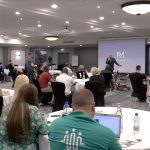If you want to build an engaged audience you need to tell stories in your business.
It is 24 January 1984 and Microsoft PowerPoint (and Apple Keynote) have yet to be invented. This is not a problem for Steve Jobs as he takes the stage at an Apple shareholders meeting dressed in a double-breasted jacket and bow tie.
“The loser now will be later to win, for the times they are a changin’,” he says, quoting Bob Dylan and letting the audience of over 2,000 employees, shareholders, board members, and reporters know that this is not going to be any old corporate update.
Speaking in a low tone, Jobs introduces the villain in his story…
“It is 1958. IBM passes up the chance to buy a fledgling company that has just invented a new technology, called Xerography. Two years later Xerox is born and IBM has been kicking itself ever since. It is 10 years later, the late 60s. Digital Equipment and others invent the mini computer. IBM dismisses the mini computer as too small to do serious computing and unimportant to their business. DEC grows to become a multi hundred million dollar corporation before IBM finally enters the mini computer market.”
His voice grows louder.
“It is now ten years later. The late 70s. In 1977, Apple, a young fledgling company on the west coast invents the Apple II, the first personal computer as we know it today. IBM dismisses the personal computer as too small to do serious computing and unimportant to their business.”
Jobs adds dramatic tension and little humour and has the audience on the edge of their seats.
“It is now 1984. It appears IBM wants it all. Apple is perceived to be the only hope to offer IBM a run for its money. Dealers, originally welcoming IBM with open arms, now fear an IBM dominated and controlled future. They are increasingly turning back to Apple as the only force that can ensure their future freedom! IBM is aiming its guns to the last obstacle to industry control – Apple. Will Big Blue dominate the entire computer industry? The entire information age? Was George Orwell right?”
The thing that made Steve Jobs’ legendary product launches so engaging was his mastery of storytelling.
Steve Jobs knew how to use stories to connect with and motivate his audience.
So how can you tell stories in your business? Here are 5 key tips
#1 – Start with the end in mind
What is the point you are trying to make with your story? Get clear on the outcome you are trying to demonstrate and then work backward from there.
Most stories are broken into three acts, where the final act reveals the moral of the story or the final outcome.
Act two sets up the final act and is typically takes us on a journey, looking for a solution to a problem.
Act one sets up act two, typically by giving some background and scene setting and then introducing a problem.
#2 – Describe the characters in your story
Steve Jobs was an expert at introducing characters in his business presentations and showing us the heroes (Apple) and the villains (Big Blue).
When crafting your stories make sure you shape the cast members and allow your audience members to get to know them.
This may involve sharing your mistakes, failed attempts at success or false wins. Remember that most people admire a character more for trying than for their successes.
#3 – Focus on your audience NOT you
When designing your stories remember to stay focused on what your audience needs to hear. This may be different from what you want to tell.
You need to share things that are relevant to the person consuming your stories and the overall outcome.
If some of your story content isn’t essential then it is likely you are including it for the wrong reasons.
#4 – Simplify and edit
The audio book of the official Steve Jobs biography is 25 hours long, the movie based on it lasts just 2 hours.
When telling business stories, what can you simplify, combine or condense?
Ideally you want to keep your stories short, whilst still getting the key points across.
#5 – Make it fun
Your business stories should entertain and inspire your audience.
Don’t be afraid to include some humour and show your audience that you are human.
Remember, even Superman isn’t perfect (and DONE beats perfect anyway!)









